- DCCA Home
- DCCA House Tour
- 1712 R Street
1712 R Street NW
1712 R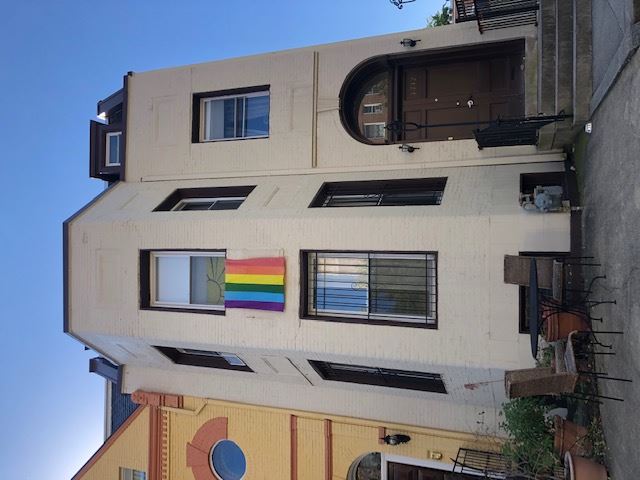 Street NW was built in 1902 by John H. Nolan, builder, and Ward Brown, architect. Ward Brown, was secretary of the Washington chapter of the American Institute of Architects and prominent in the rapidly growing city. Brown went on to design of the Nuns of the Battlefield monument at the corner of M Street and Rhode Island Avenue NW, which is listed in the National Register of Historic Places, the large property which is now the residence of the Netherlands ambassador at 2347 S Street NW and the property at 2343 Massachusetts Ave NW which is now the Embassy of Croatia.
Street NW was built in 1902 by John H. Nolan, builder, and Ward Brown, architect. Ward Brown, was secretary of the Washington chapter of the American Institute of Architects and prominent in the rapidly growing city. Brown went on to design of the Nuns of the Battlefield monument at the corner of M Street and Rhode Island Avenue NW, which is listed in the National Register of Historic Places, the large property which is now the residence of the Netherlands ambassador at 2347 S Street NW and the property at 2343 Massachusetts Ave NW which is now the Embassy of Croatia. The property at 1712 R St NW was remodeled in 1918 with Clarke Waggaman (1877-1919) as the architect. The architectural firm of Clarke Waggaman and George N. Ray was in much demand from Washington's socially and politically prominent early twentieth-century citizens. They designed imposing rows, individual town houses, and elegant mansions throughout the Dupont, Sheridan, and Massachusetts Avenue Heights neighborhoods. They were known for their careful interior decoration. Their distinctive offering to Washington's architectural scene was a tradition of a “new American house”, fusing traditional eighteenth-century formal English colonial elements with contemporary ideas. During his 14-year architectural career, Mr. Waggaman was responsible for over 100 major commissions in Washington. Other buildings which he designed in the immediate neighborhood include the 1914 building at 1627 New Hampshire Avenue NW for Dr. Louis and Marie Lehr, which now houses the Embassy of Nicaragua and the headquarters of the German Marshall Fund of the United States, at 1744 R Street NW, constructed in 1915 for the Honorable and Mrs. Alban B. Butler.
Mr. Waggaman’s designs for 1712 R St were grand with imposing first floor reception rooms and the trend-setting incorporation of an automobile garage in the basement.
Home to an important resident of the neighborhood
In 1939, Elder Lightfoot Solomon Michaux, Minister of the Church of God was resident at 1712 R St.
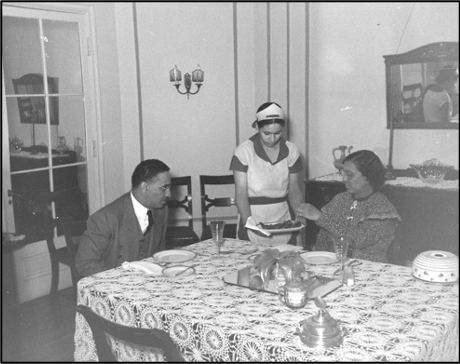
Born in Newport News in 1883, he was the son of a “French, Indian, Jewish and black merchant sailor” and his biracial wife. Elder Michaux attended the Baptist-run ‘22nd Street Negro School’ in Newport News until 4th grade, before continuing in the family business selling seafood. By 1904, he was able to open his own seafood and poultry business and a dancing school where he met Mary Eliza Pauline, later to be his wife. As a prosperous entrepreneur, he had a large house built in Newport News and, with his wife, began raising two of his younger sisters. In 1918 he was ordained in the Church of Christ (Holiness) and he founded a church in Hopewell, Virginia which offered material help as well as spiritual guidance.
seafood. By 1904, he was able to open his own seafood and poultry business and a dancing school where he met Mary Eliza Pauline, later to be his wife. As a prosperous entrepreneur, he had a large house built in Newport News and, with his wife, began raising two of his younger sisters. In 1918 he was ordained in the Church of Christ (Holiness) and he founded a church in Hopewell, Virginia which offered material help as well as spiritual guidance.
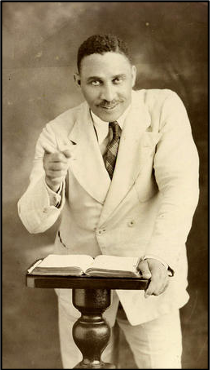 Elder Michaux transformed a local radio show (WJSY LP FM, Newport, VT: a religious radio station serving the Newport, VT area) into a nationally broadcast evangelical trumpet call - one that drew 25 million listeners each week and made him the best-known black religious figure in America during the Depression and post-war years. By 1929, he was broadcasting from his new church in the capital, where he soon became nationally known as the "Happy Am I” preacher from the show's signature song. His CBS program was influential and he stumped for Franklin Roosevelt in 1932 as African Americans made the historic shift from Republican to Democrat. He contracted with the BBC for two broadcasts in 1936 and 1938, making him an early pioneer in international radio ministry. In 1947 he began broadcasting the Elder Michaux program on television station WTTG which eventually was broadcast on the DuMont Television Network from 1948 to 1949 making him among the earliest U.S. television shows with an African American host.
Elder Michaux transformed a local radio show (WJSY LP FM, Newport, VT: a religious radio station serving the Newport, VT area) into a nationally broadcast evangelical trumpet call - one that drew 25 million listeners each week and made him the best-known black religious figure in America during the Depression and post-war years. By 1929, he was broadcasting from his new church in the capital, where he soon became nationally known as the "Happy Am I” preacher from the show's signature song. His CBS program was influential and he stumped for Franklin Roosevelt in 1932 as African Americans made the historic shift from Republican to Democrat. He contracted with the BBC for two broadcasts in 1936 and 1938, making him an early pioneer in international radio ministry. In 1947 he began broadcasting the Elder Michaux program on television station WTTG which eventually was broadcast on the DuMont Television Network from 1948 to 1949 making him among the earliest U.S. television shows with an African American host.
The church grew and by 1945, Elder Michaux had established churches along the eastern seaboard. His annual baptisms involved up to 35,000 followers and featured mass choirs, precision marchingbands and fireworks, plus, in 1950, 600 gallons of holy water from the river Jordan.
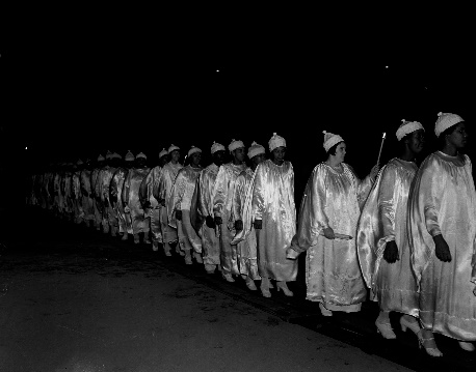 |
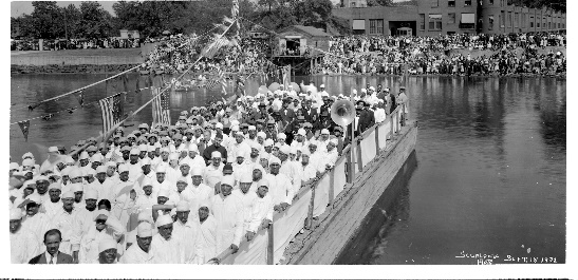 |
|
Line up for mass baptism by Elder Lightfoot Solomon Michaux (1885-1968) of the Church of God Temple of Freedom |
Group baptism on Elder Michaux's flag-bedecked barge along the Potomac River, 1932 (from Smithsonian Institution Archives) |
His activist ministry assisted the poor and homeless. In 1933, Elder Michaux assumed the management of McFadden’s Café, a health food café located at 1727 Seventh Street NW Washington DC. Under his management, the restaurant flourished and became the forerunner of the Happy News Café, where meals were free to those who had no funds. He provided housing for the homeless and a Home for Evicted Families was established. All residents contributed their wages to the General Fund and all bills were paid and good food provided. The sick were taken care of and all medical bills were paid, clothing was provided, and storage was provided for the belongings of people evicted from their homes until they found new accommodation. The Church also started an employment agency for both church and community members.
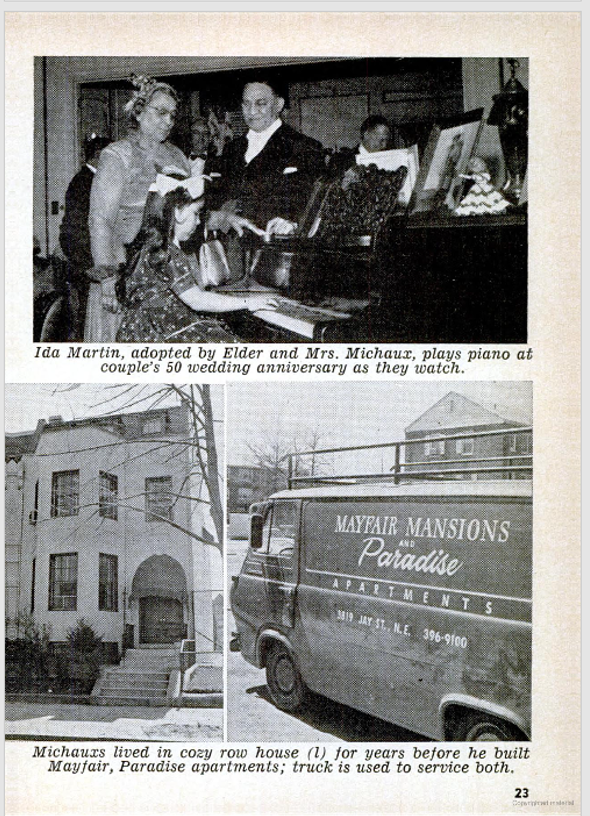 With a government loan, around 1945 Elder Michaux built one of the largest privately owned housing developments for African Americans in the United States, a 594-unit apartment housing complex in Washington D.C. called Mayfair Mansions. He published a monthly newspaper called Happy News that had a circulation of over 8,000.
With a government loan, around 1945 Elder Michaux built one of the largest privately owned housing developments for African Americans in the United States, a 594-unit apartment housing complex in Washington D.C. called Mayfair Mansions. He published a monthly newspaper called Happy News that had a circulation of over 8,000.
In 1961 he participated in a debate with Black Muslim leader Elijah Muhammad and participated in a Cold War mission to drop Bibles on the then Soviet Union.
In 1936 Elder Michaux began purchasing land along the James River near Jamestown Island in James City County, Virginia. He envisioned the development of a grand memorial which would include “an Administration Building, a commodious Auditorium, a Library Building and a Hall of Fame, where will be preserved for all times, paintings, busts and statuary of the leaders of the Race in every field of service and high endeavor. This recognition will be an inspiration to the generations to follow, to emulate the examples of their fathers, who, given their freedom became loyal citizens of the States and the Republic, with the dedication of their lives in Peace and War.” Elder Michaux invoked the history of African Enslavement, the historical significance of the founding of the colony at Jamestown and the landing of the first African slaves at Jamestown, and the historical evolution of the concept of human freedom as expressed by Washington, Jefferson, Madison and even Robert E. Lee in his description of the project.
The Memorial site, which eventually grew to about 1,100 acres, is situated in Colonial National Historical Park adjacent to Jamestown, Williamsburg, and Yorktown. It is possible that the earliest African slaves in Virginia and America worked on or near this land and that the land itself is the site of the first farm in Virginia owned by a former slave.
Elder Michaux died in Washington on October 20, 1968, after suffering a stroke. Over 3,000 people attended his funeral in Newport News. He is buried with his wife at Pleasant Shade Cemetery in Hampton.
1712 R Street NW remains the property of the Gospel Spreading Church and is currently a rental property.